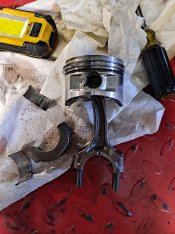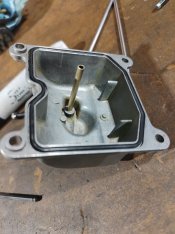Certainly an well-hammered topic, let's see if there's any new great thoughts.
I picked up an '01 in halfway decent shape apart from a predicted hydrolock issue. 0nly 28,000 miles and some nice parts, including brand-new Avons. I am a sucker for new tires.
The bike was being sold only a few blocks away and the price was right.
So I actually rode it home and it ran pretty well, indeed, apart from that fairly fearsome clatter from the port side. It was much smoother-running, less vibey, than my long-ago '86 and more recent '99 junker, even at over 6,000rpm.
But danged if cylinder #2 failed the depth-gauge bent rod test by about 3mm. And the compressions were 165, 121, 170, 173.
So what next? I looked around for Ebay motors and that path looks to be a thousand bucks. I don't mind the labor changing it out, tinkering with bikes is what I do for fun.
I can't see, though, splitting the cases and changing a rod. That looks pretty crazy for an inexpensive bike that isn't in otherwise mint condition.
My plan is to stick it in the storage unit and just sort of wait until an inexpensive motor or crash bike comes along.
The devil on my shoulder says, ride it. Yeah, but what happens then? Flying internals?
Bill
I picked up an '01 in halfway decent shape apart from a predicted hydrolock issue. 0nly 28,000 miles and some nice parts, including brand-new Avons. I am a sucker for new tires.
The bike was being sold only a few blocks away and the price was right.
So I actually rode it home and it ran pretty well, indeed, apart from that fairly fearsome clatter from the port side. It was much smoother-running, less vibey, than my long-ago '86 and more recent '99 junker, even at over 6,000rpm.
But danged if cylinder #2 failed the depth-gauge bent rod test by about 3mm. And the compressions were 165, 121, 170, 173.
So what next? I looked around for Ebay motors and that path looks to be a thousand bucks. I don't mind the labor changing it out, tinkering with bikes is what I do for fun.
I can't see, though, splitting the cases and changing a rod. That looks pretty crazy for an inexpensive bike that isn't in otherwise mint condition.
My plan is to stick it in the storage unit and just sort of wait until an inexpensive motor or crash bike comes along.
The devil on my shoulder says, ride it. Yeah, but what happens then? Flying internals?
Bill






